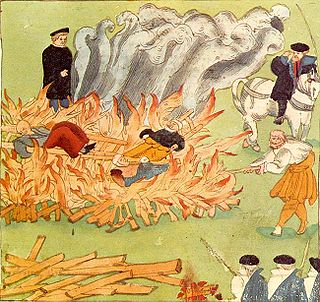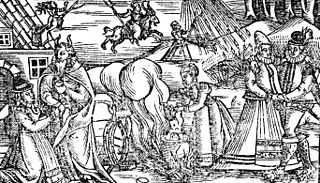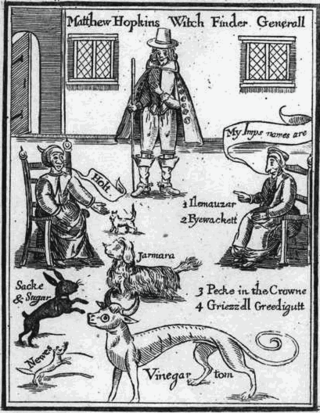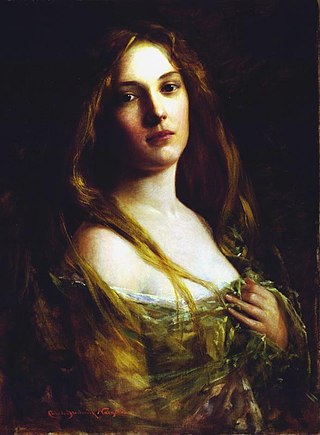Related Research Articles

A witch-hunt, or a witch purge, is a search for people who have been labeled witches or a search for evidence of witchcraft. The classical period of witch-hunts in Early Modern Europe and Colonial America took place in the Early Modern period or about 1450 to 1750, spanning the upheavals of the Reformation and the Thirty Years' War, resulting in an estimated 35,000 to 50,000 executions. The last executions of people convicted as witches in Europe took place in the 18th century. In other regions, like Africa and Asia, contemporary witch-hunts have been reported from sub-Saharan Africa and Papua New Guinea, and official legislation against witchcraft is still found in Saudi Arabia and Cameroon today.

Isobel Gowdie was a Scottish woman who confessed to witchcraft at Auldearn near Nairn during 1662. Scant information is available about her age or life and, although she was probably executed in line with the usual practice, it is uncertain whether this was the case or if she was allowed to return to the obscurity of her former life as a cottar’s wife. Her detailed testimony, apparently achieved without the use of violent torture, provides one of the most comprehensive insights into European witchcraft folklore at the end of the era of witch-hunts.
In England, Scotland, Wales, and Ireland, and the British colonies, there has historically been a succession of Witchcraft Acts governing witchcraft and providing penalties for its practice, or—in later years—rather for pretending to practise it.

The North Berwick witch trials were the trials in 1590 of a number of people from East Lothian, Scotland, accused of witchcraft in the St Andrew's Auld Kirk in North Berwick on Halloween night. They ran for two years, and implicated over 70 people. These included Francis Stewart, 5th Earl of Bothwell, on charges of high treason.

Castlegate is a small area of Aberdeen, Scotland, located centrally at the east end of the city's main thoroughfare Union Street. Generally speaking, locals consider it to encompass the square at the end of Union Street where the Mercat Cross and Gallowgate are located.
The witch trials of Vardø were held in Vardø in Finnmark in Northern Norway in the winter of 1662–1663 and were one of the biggest in Scandinavia. Thirty women were put on trial, accused of sorcery and making pacts with the Devil. One was sentenced to a work house, two tortured to death, and eighteen were burned alive at the stake.

Janet Horne was the last person to be executed legally for witchcraft in the British Isles.
The Islandmagee witch trials were two criminal trials in Carrickfergus in 1711 for alleged witchcraft at Islandmagee. It is believed to have been the last witch trial to take place in Ireland.
The Great Scottish Witch Hunt of 1597 was a series of nationwide witch trials that took place in the whole of Scotland from March to October 1597. At least 400 people were put on trial for witchcraft and various forms of diabolism during the witch hunt. The exact number of those executed is unknown, but is believed to be about 200. The Great Scottish Witch Hunt of 1597 was the second of five nationwide witch hunts in Scottish history, the others being The Great Scottish Witch Hunt of 1590–91, The Great Scottish Witch Hunt of 1628–1631, The Great Scottish witch hunt of 1649–50 and The Great Scottish Witch Hunt of 1661–62.

In early modern Scotland, in between the early 16th century and the mid-18th century, judicial proceedings concerned with the crimes of witchcraft took place as part of a series of witch trials in Early Modern Europe. In the late middle age there were a handful of prosecutions for harm done through witchcraft, but the passing of the Witchcraft Act 1563 made witchcraft, or consulting with witches, capital crimes. The first major issue of trials under the new act were the North Berwick witch trials, beginning in 1590, in which King James VI played a major part as "victim" and investigator. He became interested in witchcraft and published a defence of witch-hunting in the Daemonologie in 1597, but he appears to have become increasingly sceptical and eventually took steps to limit prosecutions.
Margaret Bane also called Clerk, was a Scottish midwife and prominent victim of The Great Scottish Witch Hunt of 1597.

The Pittenweem witches were five Scottish women accused of witchcraft in the small fishing village of Pittenweem in Fife on the east coast of Scotland in 1704. Another two women and a man were named as accomplices. Accusations made by a teenage boy, Patrick Morton, against a local woman, Beatrix Layng, led to the death in prison of Thomas Brown, and, in January 1705, the murder of Janet Cornfoot by a lynch mob in the village.

Margaret Aitken, known as the Great Witch of Balwearie, was an important figure in the great Scottish witchcraft panic of 1597 as her actions effectively led to an end of that series of witch trials. After being accused of witchcraft Aitken confessed but then identified hundreds of women as other witches to save her own life. She was exposed as a fraud a few months later and was burnt at the stake.
Marie Lamont, also referred to as Mary Lawmont (1646–1662), was executed for witchcraft during the reign of Charles II just after Witchmania had peaked in the United Kingdom. Her youth at the time of her execution made her case unusual.

Grissel Jaffray was a Scottish woman burned at the stake having been accused of witchcraft. Jaffray was one of an estimated 4000 to 6000 people who were tried during the Scottish Witch Trials of this period. She was the last person burned for witchcraft in Dundee and is commemorated in the city with a plaque and a mosaic marking the place of her execution.

In England, witch trials were conducted from the 15th century until the 18th century. They are estimated to have resulted in the death of perhaps 500 people, 90 percent of whom were women. The witch hunt was as its most intense stage during the English Civil War (1642–1651) and the Puritan era of the mid-17th century.
Margaret Barclay, was an accused witch put on trial in 1618, 'gently' tortured, confessed and was strangled and burned at the stake in Irvine, Scotland. Her case was written about with horror by the romantic novelist Sir Walter Scott, and in the 21st century, a campaign for a memorial in the town and for a pardon for Barclay and other accused witches was raised in the Scottish Parliament.
Witches of Scotland was a campaign for legal pardons and historic justice for the people, primarily women, convicted of witchcraft and executed in Scotland between 1563 and 1736. A pardon and an apology was made on 8 March 2022. The aim was also to establish a national memorial for the convicted from the Scottish parliament.

Gentile Budrioli, also known as Gentile Cimieri, was an Italian astrologist and herbal healer active in Bologna in the late 15th century. She studied at the University of Bologna and also received lessons from Franciscan friars. Budrioli drew attention from her contemporaries for her great skill in healing and she became a close friend of Ginevra Sforza, the wife of Bologna's ruler Giovanni II Bentivoglio. As a result of this, Budrioli rapidly rose through the ranks in the city and briefly served as a councilor at the Bolognese court.

The Katarina witch trials took place in the Katarina Parish in the capital of Stockholm in Sweden in 1676. It was a part of the big witch hunt known as the Great noise, which took place in Sweden between the years 1668 and 1676, and it also illustrated the end of it.
References
- ↑ "The Strange Case of Janet Wishart, the Great Witch of Scotland". Mysterious Universe. Retrieved July 29, 2022.
- 1 2 3 4 5 "The Silver City Vault::Stop 3: Janet Wishart (died 1597), Mercat Cross, Castlegate". Silver City Vault. Retrieved July 29, 2022.
- 1 2 3 4 5 Scott (Oct 31, 2016). "Wishart Witches - Wishart Connections". Wishart Society. Retrieved July 29, 2022.